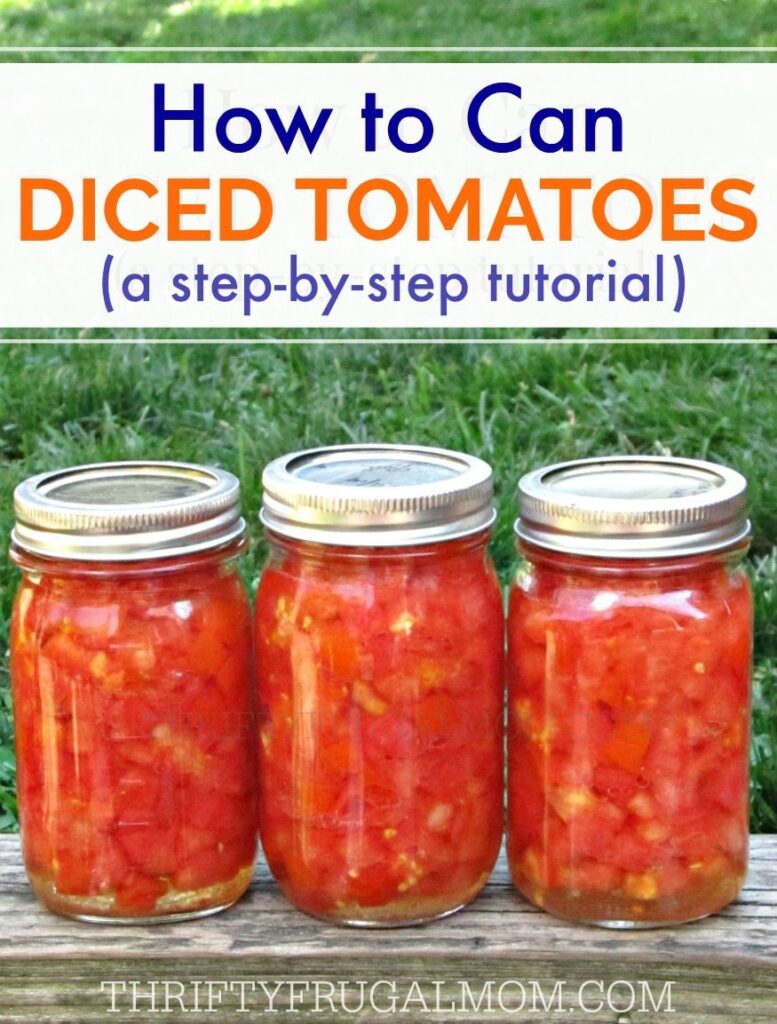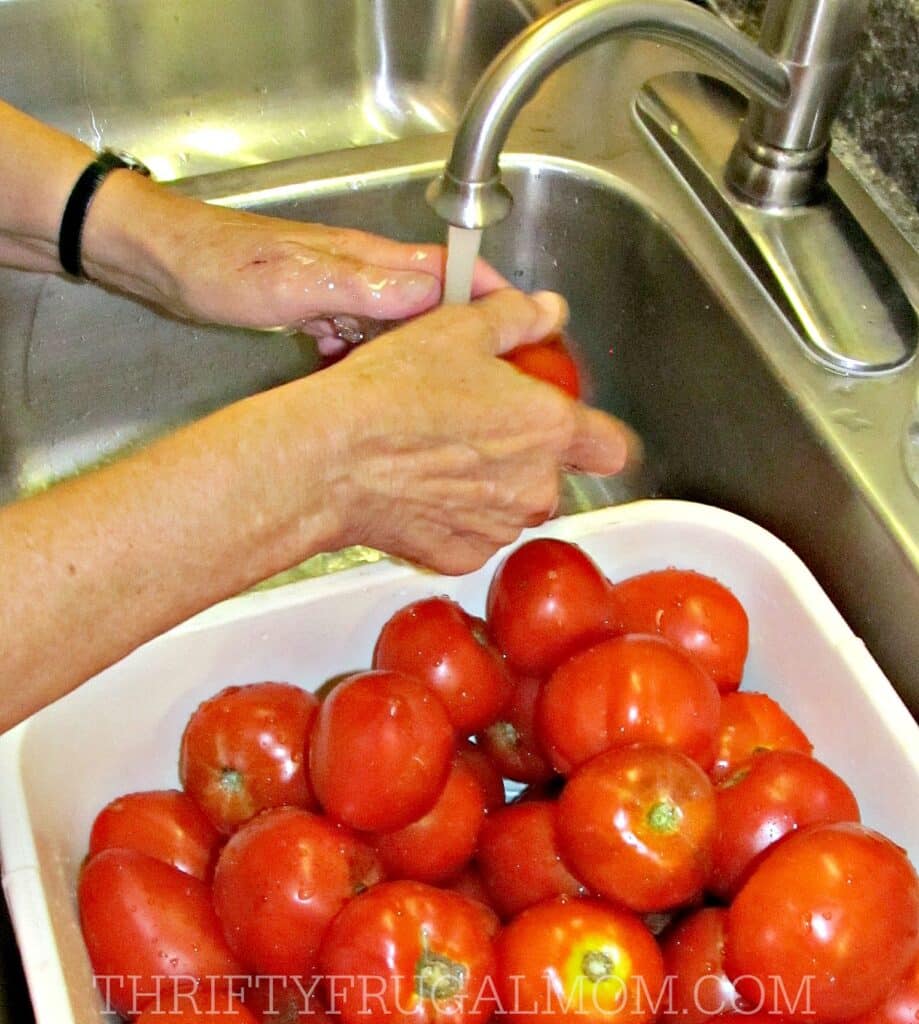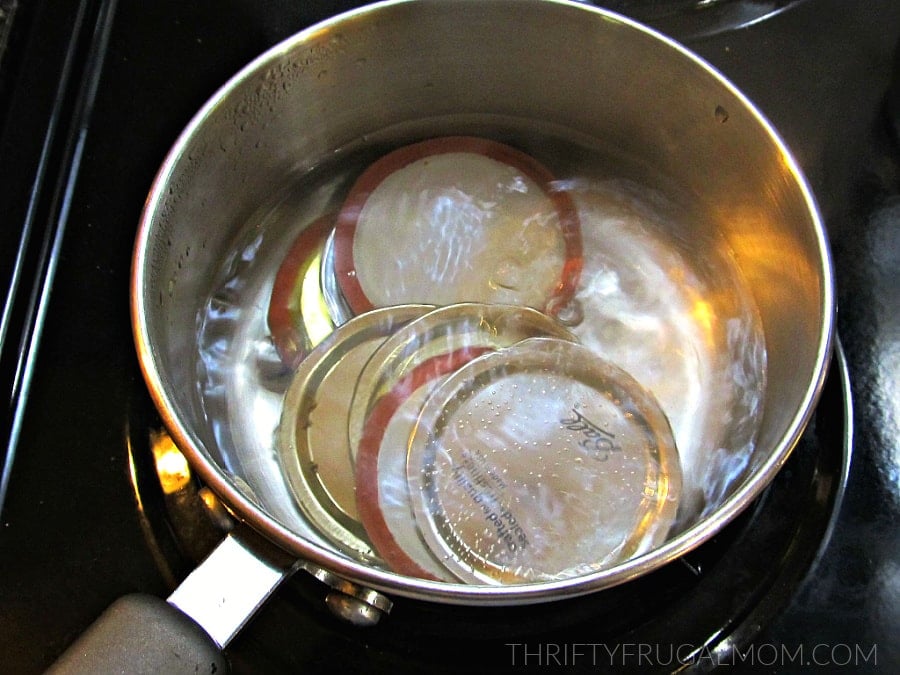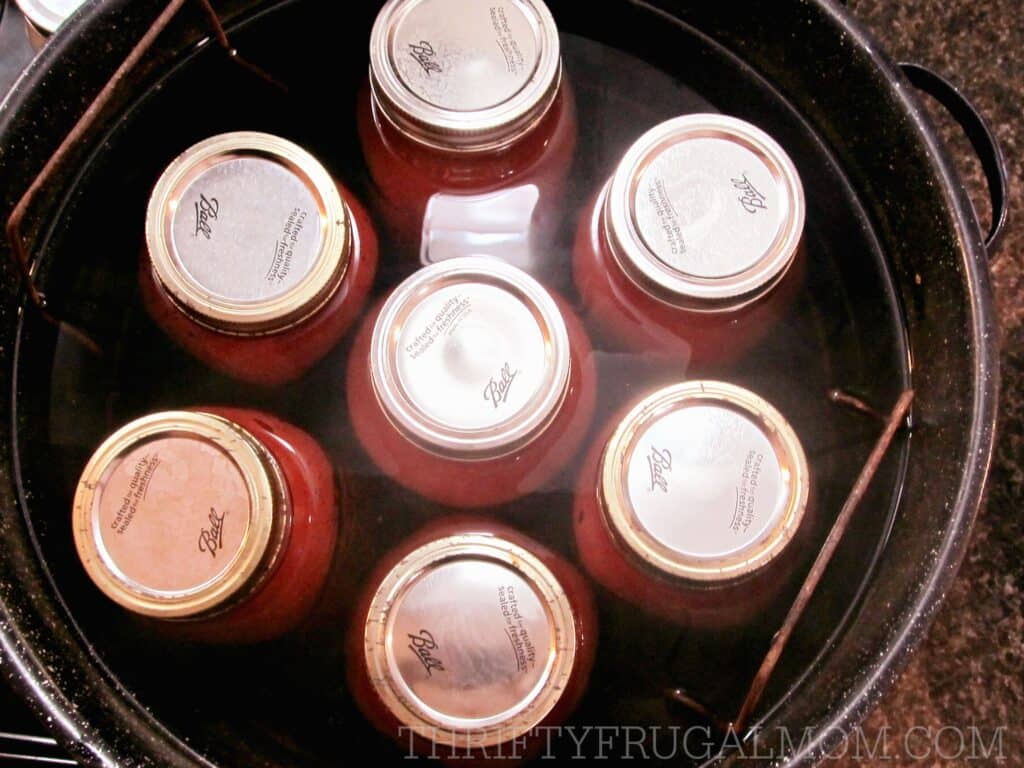The absolute easiest way to can tomatoes! This step-by-step photo tutorial will show you how to can tomatoes in no time. No peeling, no coring- just cut out the stem and dice them up. It’s super easy, plus if you grow your own tomatoes, it’s a big money saver too!

I started canning diced tomatoes several years ago after having an “aha moment” one evening while preparing dinner. As I was opening a can of diced tomatoes that I needed for the recipe I was making, I suddenly wondered why in the world I never tried canning them myself. I mean how hard could it be?
I grew up helping my mom can tomato juice and tomato chunks. And every year since we’ve been married, I’ve canned tomato juice as well as things like salsa and marinara sauce, so I was quite familiar with the process of canning tomatoes.
I decided to give it a try and it worked like a charm! It was not only super simple, it has also saved me from needing to buy diced tomatoes from the store.
How do you can tomatoes? Let me help you learn the process!
Supplies for Canning Tomatoes
There are affiliate links in this post. As an Amazon Associate, I earn from qualifying purchases. Please read my full disclosure policy.
- Tomatoes, salt and bottled lemon juice
- Dishpan or containers to put the tomatoes in
- Knife (This one is my favorite for slicing tomatoes!)
- Cutting board (The groove on this one is awesome because it catches the juice, creating less mess.)
- Vidalia Chop Wizard (Not a necessity, but you can dice the tomatoes in about half the time if you use it.)
– This gadget is also awesome for dicing tomatoes, onions, and peppers for salsa and potatoes and carrots for soups. - Wide Funnel
- Damp cloth to wipe jar rims
- Water Bath Canner (or this Canning Rack may work depending on what size pot you already own)
- Canning jars with lids and rings
- Jar lifter
- Old towels or rags to set the hot jars on
How to Can Diced Tomatoes- a step-by-step tutorial

1. Wash tomatoes thoroughly.
Cut out the stem and any defects or blemishes.
Some people also peel the tomatoes, but I never do and we honestly have not noticed the peelings at all and I’m even funny about textures like that in food.
I figure, why bother with the extra step? Plus it’s a bit healthier too!

2. Cut up the tomatoes.
Slice tomatoes into about ½-inch thick slices, then dice them into whatever size you want. I love using the large dicing side of my Vidalia Chop Wizard for this!

3. Place diced tomatoes into a clean canning jar.
A funnel makes this super easy. Gently shake the jar to settle the tomatoes so that you can fill it completely.
The tomatoes should be packed tightly to produce enough juice. It won’t hurt if you press down on them a bit to get the jar packed full- in fact, this is probably going to be necessary.
The jar should be full to the base of the neck.

4. Add salt and bottled lemon juice.
For the salt, use ½ tsp. per pint and 1 tsp. per quart. You do not need to add salt when canning tomatoes, but I recommend it because I think it helps enhance the flavor.
For the lemon juice, use 1 Tbsp. per pint and 2 Tbsp. per quart.
Once the salt and lemon juice are added to the tomatoes, wipe the rim of each canning jar with a damp cloth to remove any tomato residue that may be there. (If there is even a slight bit of tomato juice on it, it may not allow it to seal properly.)
I updated the original post to include the instructions to add lemon juice after several readers commented and said that to be safe, you really should add it.

5. Prepare the canning lids. (This may be optional!)
Update: Some canning lid manufacturers now say that it’s not necessary to preheat the lids. So before doing this, check the instructions that came with the lids you are using.
Once you have 7 jars filled, place 7 metal canning lids in a small pan. Cover with water; bring to a boil.
When the water boils, use a fork or lid lifter to lift the jar lids out of the water and place them on the jars. Be careful not to burn yourself!
Secure each lid with a jar band/ring. (Heating the lids softens the rubber, allowing for a better seal.)

6. Place the filled jars of tomatoes in the canner.
Once jars are full and have the ring and lids on them, place them in the canner.
Then add hot water to the canner, enough to cover the jars by 1 to 2 inches. Cover the canner with a lid. Turn the burner to medium-high heat.
Once the water starts to boil, reduce the heat slightly and process for 45 minutes, making sure the water is boiling gently and steadily the whole time. (You may need to adjust the heat to keep the boil going nicely, but as long as it is boiling, you are fine.)

7. Remove the jars of canned tomatoes.
After processing the canned tomatoes for 45 minutes, turn the burner off.
Remove jars using a jar lifter- you may want to have a dishrag in your other hand to catch any hot water that drips from the jars as you remove them- and place on an old towel, blanket or another padded surface. (This is to protect your counter from the super hot jars.)
Allow at least a little bit of air space around each jar, making sure not to have jars close enough to touch. Do not move until the jars are completely cool.
Jars should seal as they cool and you will typically hear a snap or pinging sound as the vacuum seal is formed. The lids will be slightly concave when sealed.
To test the seal, once the jar has totally cooled you can lightly tap the center of the cooled jar lid. If it is firm and does not move, it should be sealed. If it pushes in, it didn’t seal properly. You can still use unsealed jars, just put them in the refrigerator and use them as soon as possible.
After the jars are completely cool, you can remove the rings. Jars should be wiped clean before storing them.
Enjoy!
HELPFUL TIP: 1 pint of canned diced tomatoes is equivalent to 1 (15 oz.) can of diced tomatoes.
Other canning recipes you might also enjoy:
How to Can Diced Tomatoes
Equipment
- Dishpan or containers to put the tomatoes in
- Knife
- Cutting board
- Vidalia Chop Wizard (Not a necessity, but you can dice the tomatoes in about half the time if you use it.)
- Wide Funnel
- Damp rag to wipe tops of jars
- Canner
- Canning jars with lids and rings
- Jar lifter
- Old towel, blanket or other padded surface to put hot jars on
Ingredients
- fresh tomatoes (approximately 2 3/4 lb. for 1 quart jar)
- salt (1 tsp. per quart or 1/2 tsp. per pint)
- bottled lemon juice (2 tbsp. per quart or 1 tbps. per pint)
Instructions
- Wash tomatoes thoroughly. Cut out the stem and any defects or blemishes. Some people also peel the tomatoes, but I never do and we honestly have not noticed the peelings at all- and I’m even funny about textures like that in food. I figure why bother with the extra step, plus it’s a bit healthier too!
- Slice tomatoes into about ½ inch thick slices, then dice them into whatever size you want. I love using the large dicing side of my Vidalia Chop Wizard for this!
- Place diced tomatoes into a clean canning jar- a funnel makes this super easy. Gently shake jar to settle tomatoes so that you can fill it completely. The tomatoes should be packed tightly in order to produce enough juice. It won't hurt if you press down on them a bit to get the jar packed full- in fact, this is probably going to be necessary. The jar should be full to the base of the neck.
- Add salt (½ tsp. per pint and 1 tsp. per quart) and bottled lemon juice (1 Tbsp. per pint and 2 Tbsp. per quart). Wipe rim of each jar with a damp cloth to remove any tomato residue that may be there. (If there is even a slight bit of tomato juice on it, it may not allow it to seal properly.)
- Update: Some canning lid manufacturers now say that it's not necessary to preheat the lids. So before doing this, check the instructions that came with the lids you are using. Once you have 7 jars filled, place 7 metal canning lids in a small pan. Cover with water; bring to a boil. Once the water boils, use a fork or lid lifter to lift the jar lids out of the water- be careful not to burn yourself!- and place them on the jars. Secure each lid with a jar band/ring. (Heating the lids softens the rubber, allowing for a better seal.)
- Place 7 jars in canner. Fill with enough hot water to cover the jars by 1 to 2 inches. Cover canner with a lid. Turn the burner on medium high heat. Once water starts to boil, reduce heat slightly and process for 45 minutes, making sure the water is boiling gently and steadily the whole time. (You may need to adjust heat to keep the boil going nicely, but really, as long as it is boiling, you are fine.)
- After processing for 45 minutes, turn the burner off. Remove jars using jar lifter- you may want to have a dishrag in your other hand to catch any hot water that drips from the jars as you remove them- and place on an old towel, blanket or another padded surface. (This is to protect your counter from the super hot jars.) Allow at least a little bit of air space around each jar, making sure not to have jars close enough to touch. Do not move until jars are completely cool.
- Jars should seal as they cool and you will typically hear a snap or pinging sound as the vacuum seal is formed. Lids will be slightly concave when sealed. To test the seal, once jar has totally cooled, lightly tap the center of the cooled jar lid. If it is firm and does not move, it should be sealed. If it pushes in, it didn’t seal properly. You can still use unsealed jars, just put them in the refrigerator and use them as soon as possible.
- After jars are completely cool, you can remove the rings. Jars should be wiped clean before storing them.





Josh
Can you use fresh lemon juice?
Lydia Beiler
Experts don’t recommend using fresh lemon juice because it can vary in acidity. Bottled lemon juice has to meet a standard level of acidity and it’s the acidity that is necessary to make sure the tomatoes are acidic enough to avoid bad bacteria.
Mary
Can you use a pressure cooker if you don’t have a canner
Lydia Beiler
No, that works quite differently and would not can the food properly.
Paige
Why do you say to remove the rings once the jars are completely cooled – aren’t those necessary to hold down the kids?
Lydia Beiler
No, because at that point your lid should be sealed and the ring is no longer needed. Leaving it on can cause the ring to rust and/or mold to even possibly grow if any of the food got under the ring during the canning process. By removing the ring, it is also easier to detect if a jar has a faulty seal and didn’t seal when canning. I’m not really sure of any good reason to leave it on, I suppose.
Jennifer Harvey
Hello Lydia,
I’m just wondering am I able to put a little bit if citric acid in place of the lemon juice? Would I still need to put in a little salt in too? I’m canning for the first time, 😊 so far I find your steps easy to follow for canning… Thank you so much
Lydia Beiler
Yes, Jennifer, you can definitely use citric acid in place of lemon juice. Just add 1/4 tsp. per pint and 1/2 tsp. per quart. You will also still need to add the salt just like the recipe states (unless you don’t want salted tomatoes). And yay for getting started with canning! I’m so honored that this is the first recipe you are trying and happy to hear that it’s been easy to follow. Happy canning!
Marc
The “suction” from sealing holds the lid securely. Bumping roughly MAY “pop” it off, but in years of canning with my grandmother, none ever popped loose.
Fred
You forget to mention that once filled jars will still have air in them. Thus will float in water bath
Lydia Beiler
In my expereince, the jars actually shouldn’t float if they are filled properly.
Leslie
Does it matter what kind of salt to use?
Lydia Beiler
I just use regular table salt or sea salt, but pickling salt is fine too. If you can get table salt that doesn’t include iodine, that is best as the iodine can make the liquid cloudy and sometimes also affects the color of the tomatoes a bit.
Marc
I never use iodized salt as the iodine compounds MAY affect flavor.
Lydia Beiler
The interesting thing is, when my mom and grandmother canned they only ever used regular salt, which of course was iodized.
Lydia Douglas
Done this morning. I used my Starfrit dicer. Usually when buying can tomatoes I buy just plain diced. Wish I can send a picture. Well done!!
Lydia Beiler
Go you, Lydia! I wish too that there was a way to attach a picture here. That would be fun!
Ps. It was also neat to see someone else with the same name. I don’t find that very often!
Colleen
So what happens if forgot to add in salt and lemon juice?
Lydia Beiler
You can add the salt when you go to use the tomatoes. Not as handy, but it happens to all of us at one point or another when canning! What you decide regarding the lemon juice is your call. My mom and I canned tomatoes and never added lemon juice for years without any issue. That being said, the lemon juice is added to help make sure the tomatoes are acidic enough to be safely canned, especially as some newer varieties of tomatoes are less acidic than the older heirloom varieties. It also appears that according to this article, you could possibly boil them before using them to make sure they are okay?